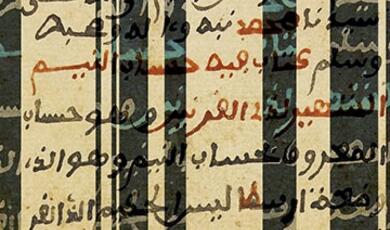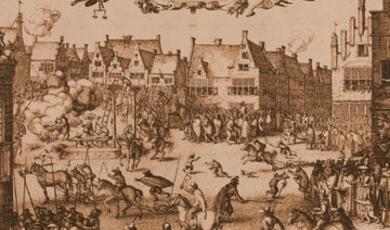Landscapes of Roman Britain
Share
- Details
- Text
- Audio
- Downloads
- Extra Reading
We used to think Roman Britain was a largely untamed natural landscape of woodland with occasional opulent villas representing the houses of an alien elite, set side by side with scattered peasant settlements. Archaeological work since the 1940s has radically altered this understanding through a combination of large-scale excavation and a revolution in remote sensing techniques, revealing a more varied picture of housing, farming, settlement and industry.
This lecture will explore our current knowledge of the nature of Roman imperialism and the history of Britain.
Download Text
Landscapes of Roman Britain
Professor Martin Millett
15th March 2023
Introduction
In the last quarter century there has been a revolution in our knowledge of the landscape of Roman Britain. This has been the result of a vast increase in the amount of evidence available for analysis – a product of changes in both how we identify past activity through archaeology as well as a growth in fieldwork in advance of development. In this lecture, I will first outline these changes and discuss how they have altered our knowledge of the landscape. I will then focus on a series of examples to illustrate how such new information enables us to think in new ways about the landscape and the people who occupied it. My prime objective is to better understand the nature of the impact of Roman imperialism on those who lived with it.
Looking back, traditional ideas about the countryside of Roman Britain are dominated by two things. First, a focus on grand houses – the villas – and second a view of a landscape largely untamed with low densities of occupation and many areas presumed to have remained as uncultivated woodlands. More broadly, at least initially, assumptions were made about the villas having been occupied by incoming Romans. Over more than 100 years these ideas have gradually been modified, with an increasing recognition that there were diverse forms of settlement, and that many of those occupying even the grand villas were the descendants of local people who had come to adopt Roman ways of living and behaviour, such that they themselves became culturally Roman. This led to debates about the nature of Roman imperial impact, and an appreciation that other styles of living also continued within Britain during this period with culture owing as much to indigenous traditions as to Roman ways (Millett 1990; Mattingly 2006).
More recently the pace of change in our knowledge has been quickened by a developments in the subject, so it is now clear from work across a range of landscapes that Roman Britain was very intensively exploited, with high population densities a very diverse characteristics, but with villas owned only by a minority. As we shall see later in this lecture, this fundamentally changes the way that we understand society. Aside from anything else, families who generally lived in close proximity to one another could enjoy more frequent and intensive social interactions in ways that were less possible in areas of very low settlement density.
New Sources of Evidence
Before turning to consider how our understanding of the landscape has changed it is worth briefly reviewing developments in how we obtain our evidence. From the 1970s, as archaeologists became more interested in the history whole landscapes rather than just individual sites, they deployed two sets of approaches (Taylor 2007). First, building on developments earlier in the 20th century, they increasingly used aerial photography to map past landscapes, since differential patterns in crop growth and ripening can reveal buried features on certain types of soils, especially in drought conditions. Hence, a range of practitioners made a fantastic contribution, by regularly flying over areas, photographing and mapping such ‘crop marks’. Although the visibility of features representing past activity varies with climate, soils and the agricultural regime, this work transformed knowledge of many areas of Britain. More recently, the ready availability of satellite imagery on-line as well as the development of software to plot the features observed on maps has made such evidence even more important.
Second, at a more local level, teams walked the fields to collect and map the surface distributions of artefacts derived from past occupation. Although more labour-intensive, such work provides helpful information about the dating as well as the distribution of past settlements in areas of arable cultivation (Millett 1990, 184, table 8.3). More recently, the systematic collection of similar evidence produced by metal-detectorists and collated through the Portable Antiquities Scheme has augmented our knowledge, especially in areas where aerial photography is less effective.
Since changes in the role of archaeology in the planning of development in 1990, developer-funded archaeological excavations has been transformative. Not only have there been many more projects designed to evaluate the impact of planned development on past landscapes, but it has become common for large-scale developments to be preceded by huge excavations (Smith et al. 2016). Since development impacts many areas where little was previously known about the archaeology, it has provided an excellent sample across the landscape in areas of intensive development, like that around Cambridge.
Finally, and partly driven by the impetus rapidly to evaluate the potential impacts of planned development, we have also seen as revolution in the evidence provided by terrestrial geophysics – largely systems that measure tiny variations in the earth’s magnetic field that can indicate the presence of buried features. Mechanization of the collection of such data and advances in the software for its analysis now enable us to map huge areas at high resolution. Used as a method for investigating whole landscapes this technology has also been transformative.
Recent Syntheses
Recently, a major research project (the Roman Rural Settlement Project) has drawn together the evidence from developer-funded excavation, and used this as the basis for a substantial study of Roman Britain published in three volumes (Smith et al. 2016; 2018; Allen et al. 2017). This work complements an earlier study which had a broader remit, that drew on a wider range of evidence (Taylor 2007). Both sets of studies included some invaluable local syntheses as well as providing grand overviews. The Roman Rural Settlement Project drew on the evidence of 2627 excavations in England and Wales, and followed an approach that sought to identify general trends. In doing this it has fundamentally altered views of the province. In particular it has drawn attention to significant patterns regional diversity. There is an overall dominance of small farms (most of which were enclosed by ditches) rather than villas, as well as the widespread occurrence of nucleated settlements (analogous to later villages). Whilst acknowledging that the evidence has particular evidential biases, the study also concluded that the population of Roman Britain reached a maximum, estimated at c. 2 million people, during the second century AD, declining a little thereafter. I suspect that this underestimates the size of the population which I previously suggested may have reached nearer 4 million (Millett 1990, 184–85). Nevertheless, it it widely agreed that rural dwellers accounted for about 90% of the total population – strongly emphasizing the agrarian nature of society in Roman Britain.
The Roman Rural Settlement Project, as well as Jeremy Taylor’s later work (2013), provides a valuable benchmark for thinking about the nature of the landscape in Roman Britain. It further includes may work on diverse aspects of life in the province that I do not have time to address in this lecture. Building on this new knowledge, I want to take a different approach, moving away from generalized understandings based on large-scale evidence across regions to think about some key issues in which this new evidence can transform understandings. In doing this, I am largely drawing on the results of research that I have been involved in, mostly in northern England, seeking to combine local detail with broader ideas.
Transforming Understanding
Villas
During the 20th century, archaeologists came to appreciate that the majority of Roman villas in Britain evolved from Pre-Roman Iron Age settlements with most of them likely to have been occupied by local leaders rather than immigrants. The realization that most were not planted de novo raises the question of the motivation for their construction. Under the influence of ideas sympathetic to imperialism, it was often assumed that the attraction of the supposedly superior culture of Roman was natural, and that those who were able to accumulate money through trade in agricultural surplus or other goods from their land would wish to invest it in new modes of Roman display, thus encouraging the building of villas which were often taken to represent a particular economic form itself imported from the Mediterranean. This has always seemed to me to be problematic since the buildings labelled as villas in Britain bear very little resemblance to those in the Mediterranean, although they do share features in common with sites in Gaul and Germay.
The excavation of the villa at Rudston on the Yorkshire Wolds in the 1960s exemplifies work on such sites revealing some fine mosaics, bit with the trenches having their main focus on the principal buildings. As with other work at the same time there was little opportunity to relate these buildings to their broader context. Returning to the examine the site in the last decade we have been able to re-interpret the villa in its broader landscape context drawing on the evidence of geophysics and aerial photography (Ferraby et al. 2017).
In the Pre-Roman Iron Age, much of this part of the Yorkshire Wolds was divided into large landscape blocks by extensive dyke systems (Stoertz 1997) which enclosed large tracts of land probably used for animal pasture. Settlements were built around the edges of these areas, forming strings of occupied enclosures. This implies that the enclosed land was held in common with the herds controlled by the community. In the Rudston area, aerial photography shows that one of these large ranges was later subdivided into a series of strip fields, presumably for the growing of crops, and perhaps also indicating that the land was moved from communal control to private ownership. Our survey work around the villa at Rudston established the relationship between this re-organization of the landscape and the development of the villa buildings which were shown in the 1960s to overlie an earlier farm. From the aerial photos and geophysical survey we can now see that the new field systems were laid out in the second century AD, and underlie the villa buildings which were not constructed until the mid-late third century. The primary landscape re-organization, which has also been observed elsewhere on the Wolds, must represent a significant social and economic transformation, but it was not directly linked to the construction of the villa which came only a couple of generations later. Although it may be than the privatization of communal land created circumstances for the accumulation of private wealth that could be invested in villa building, but it seems that the two were not causally linked (Ferraby et al. 2017). Villa building and the use of display items like mosaics hence represent a deliberate cultural choice by the later owners, not simply an evolution.
Landscape Diversities
Elsewhere in East Yorkshire, our work at Hayton has examined a 4km x 4 km block of landscape in considerable detail, deployng aerial photography, large-scale geophysics as well as field-walking and limited excavation (Halkon et al. 2015). This work complements broader scale landscape work across the wider region as well as our previous detailed landscape survey at Holme-on-Spalding Moor (Halkon and Millett 1999). As in the area around Cambridge, intensive work has revealed a densely occupied landscape, with small farms focused on the stream that flows down from the edge of the Wolds with the inhabitants largely engaged in mixed farming with associated arable fields. Here at Hayton, the establishment of a short-lived Roman fort around AD 70 was followed by the construction of a Roman road perhaps a generation later. This connected Hayton to major centres in Roman Britain as well as the coastal seaways. This transformed the landscape, which saw a rapid growth of ribbon development along its flanks. Perhaps unsurprisingly, from what we can see, the small farms in the study area have differing histories, with some thriving and becoming integrated with the Roman economy, whilst others declined and were soon abandoned.
At broader scale in the same region, there are marked contrasts in the use of the landscape at this time. The distribution of fourth-century coinage exemplifies this mapping interactions represented by the coinage which were largely confined to a corridor along the Roman road. This does not mean that areas further from the road were unoccupied as the work in the Holme-on-Spalding Moor area demonstrates that it too was densely occupied with small enclosed settlements. However, unlike those in the Hayton area, they are rarely linked to fields and seem to represent a different form of exploitation. This low lying area had been used for iron making in the Pre-Roman Iron Age, with this industry replaced by pot making during the Roman period (after supplies of local bog iron ore had been exhausted). Both these industries relied on woodland for fuel and it seems likely that the area was one dominated by managed woodland and charcoal manufacture during the Roman period – linked to the broader economy, but perhaps engaging with it in different ways, hence the general absence of coinage. This implies that there were different life-styles even within a locality, with varied choices about how people engaged with the Roman state and its economy.
Connectivity and Culture
The inhabitants of the Hayton area were networked with a broader Roman world via the road that passed through their landscape, but they were networked regionally via the traditional route up the valley that connected the lowlands with the tops of the Wolds. There is reason to believe that this acted as a route for the seasonal movement of sheep who were grazed on the Wold tops in summer. One site we excavated next to the stream revealed a large number of deposits that probably represent feasting on sheep-meat, perhaps associated with seasonal religious celebrations. We also concluded that animals brought down seasonally were probably marketed by the roadside, with surplus stock going to supply towns like York. A large and rich concentration of finds beside the road in an area with no evidence for a permanent settlement has been interpreted as the location of a seasonal market – reminiscent perhaps of those seen in later centuries.
Returning to the area on the Wolds where we undertook fieldwork at Thwing, we may be seeing the other end of such a supply chain. Here, at one of the linear enclosure systems remote from the road system, there is surprising evidence for the deliberate burial of a number of bullion coins of different dates around the margins of the settlement. These must presumably have been obtained from trade, arguably of animals, but the inhabitants were not part of a regular monetary economy, and seem to have decided to bury the coins (as well as other ‘alien’ objects) once received. We do not understand this cultural practice, which may have some religious motivation, but we can certainly see that it was a deliberate choice, and indicates social and economic values that differ from those we have seen elsewhere.
Architectural Display
Not far from the location where coins and other objects were carefully secreted, another form of cultural choice is exemplified by the building of a farm house within another of these linear settlement enclosures (Ferraby et al. 2017). It is nearly contemporary with the villa building at Rudston close by, but represents what I suspect is a much more common building form in Roman Britain (although because of ploughing the houses in many farm sites have long ago been destroyed). At Thwing, we excavated a simple rectangular hall-type building with private chambers at either end, carefully constructed in chalk. This ‘work hall’ represents a system of communal-style living, although the building certainly has architectural features that show how it was designed to display the occupants’ status and social position. Sitting on the hill it would have been highly visible with its white walls and bright red roof. Its form, style and construction represent clear choices, and whilst comparatively modest in scale, it compares in area with a estate modern house, and is arguably the residence of people of the ‘middling sort’.
Less visible, and even more often lost through ploughing, timber buildings of similar type were probably much more common than stone in Roman Britain. Where we have evidence for them that has been well excavated, they can be seen to represent magnificent and complex, high status buildings – and key social symbols. It seems very likely that their variety and technology acted as symbols of social power albeit in different ways from Roman style villas, again emphasizing the cultural choices that were made by the diverse peoples of rural Roman Britain.
Diversity of Empire
Finally, I think it is worth noting that although in this lecture I have focused on the diversity of rural settlement with most emphasis on the aspirations of those who did not attempt to adopt a full package of Mediterranean culture, there were others in Britain who did. Some not only engaged with Graeco-Roman culture, but appear to have mastered it. Such families had, by the fourth century, become part of an empire-wide elite who shared fully in that common culture. Recent spectacular discoveries like that at Boxford (Beeson et al. 2019) remind us of this, but these discoveries should not detract from the equally interesting, if sometimes puzzling aspects of local cultures that co-existed.
In this lecture I have presented a view of the landscape of Roman Britain that emphasizes cultural diversity and choice, illustrating aspects that are, I hope, unfamiliar. This is important because one of the barriers to a full understanding of the Roman Empire is paradoxically its apparent familiarity. Although things like villas and baths make the Roman Empire look rather like the world we live in today, it is worth remembering the words of L.P Hartley in The Go Between: “The past is a foreign country: they do things differently there”.
© Professor Martin Millett 2023
References and Further Reading
Allen, M., Lodwick, L., Brindle, T., Fulford, M. and Smith, A. 2017 The Rural Economy of Roman Britain, London: Britannia monograph no. 30
Beeson, A., Nichol, M. and Appleton, J. 2019 The Boxford Mosaic: a unique survivor from the Roman Age. Newbury: Countryside Books
Breeze, D. J. (ed.) 2014 The impact of Roman on the British Countryside, London: Royal Archaeological Institute
Ferraby, R., Johnson, P., Millett, M. and Wallace, L. 2017 Thwing, Rudston and the Roman-period exploitation of the Yorkshire Wolds, Leeds: Yorkshire Archaeological Report no. 8
Halkon, P. and Millett, M. 1999 Rural Settlement and Industry: studies in the Iron Age and Roman archaeology of lowland East Yorkshire, Leeds: Yorkshire Archaeological Society Roman Antiquities Section monograph no. 4
Halkon, P., Millett, M. and Woodhouse, H. 2015 Hayton, East Yorkshire: archaeological studies of the Iron Age and Roman landscapes. Leeds: Yorkshire Archaeological Report no. 7
Jackson, R. 2020 The Roman occupation of Britain and its legacy, London: Bloomsbury
Mattingly, D. 2006 An Imperial Possession: Britain in the Roman Empire, Penguin
Millett, M. 1990 The Romanization of Britain: an essay in archaeological interpretation, Cambridge: Cambridge University Press
Millett, M. 2016 ‘By small things revealed’: Rural settlement and society. In M. Millett, A. Moore and L. Revell (eds) The Oxford Handbook of Roman Britain. Oxford: Oxford University Press, 699–719
Smith, A., Allen, M., Brindle, T., and Fulford, M. 2016 The Rural Settlement of Roman Britain, London: Britannia monograph no. 29
Smith, A., Allen, M., Brindle, T., Fulford, M., Lodwick, L. and Rohnbogner, A. 2018 Life and death in the countryside of Roman Britain, London: Britannia monograph no. 31
Stoertz, C. 1997 Ancient landscapes of the Yorkshire Wolds, London: Royal Commission on the Historical Monuments of England
Taylor, J. 2007 An atlas of Roman rural settlement, York: Council for British Archaeology
Taylor, J. 2013 Encountering Romanitas: characterising the role of agricultural communities in Roman Britain, Britannia 44, 171–90
References and Further Reading
Allen, M., Lodwick, L., Brindle, T., Fulford, M. and Smith, A. 2017 The Rural Economy of Roman Britain, London: Britannia monograph no. 30
Beeson, A., Nichol, M. and Appleton, J. 2019 The Boxford Mosaic: a unique survivor from the Roman Age. Newbury: Countryside Books
Breeze, D. J. (ed.) 2014 The impact of Roman on the British Countryside, London: Royal Archaeological Institute
Ferraby, R., Johnson, P., Millett, M. and Wallace, L. 2017 Thwing, Rudston and the Roman-period exploitation of the Yorkshire Wolds, Leeds: Yorkshire Archaeological Report no. 8
Halkon, P. and Millett, M. 1999 Rural Settlement and Industry: studies in the Iron Age and Roman archaeology of lowland East Yorkshire, Leeds: Yorkshire Archaeological Society Roman Antiquities Section monograph no. 4
Halkon, P., Millett, M. and Woodhouse, H. 2015 Hayton, East Yorkshire: archaeological studies of the Iron Age and Roman landscapes. Leeds: Yorkshire Archaeological Report no. 7
Jackson, R. 2020 The Roman occupation of Britain and its legacy, London: Bloomsbury
Mattingly, D. 2006 An Imperial Possession: Britain in the Roman Empire, Penguin
Millett, M. 1990 The Romanization of Britain: an essay in archaeological interpretation, Cambridge: Cambridge University Press
Millett, M. 2016 ‘By small things revealed’: Rural settlement and society. In M. Millett, A. Moore and L. Revell (eds) The Oxford Handbook of Roman Britain. Oxford: Oxford University Press, 699–719
Smith, A., Allen, M., Brindle, T., and Fulford, M. 2016 The Rural Settlement of Roman Britain, London: Britannia monograph no. 29
Smith, A., Allen, M., Brindle, T., Fulford, M., Lodwick, L. and Rohnbogner, A. 2018 Life and death in the countryside of Roman Britain, London: Britannia monograph no. 31
Stoertz, C. 1997 Ancient landscapes of the Yorkshire Wolds, London: Royal Commission on the Historical Monuments of England
Taylor, J. 2007 An atlas of Roman rural settlement, York: Council for British Archaeology
Taylor, J. 2013 Encountering Romanitas: characterising the role of agricultural communities in Roman Britain, Britannia 44, 171–90
Part of:
This event was on Wed, 15 Mar 2023
Support Gresham
Gresham College has offered an outstanding education to the public free of charge for over 400 years. Today, Gresham College plays an important role in fostering a love of learning and a greater understanding of ourselves and the world around us. Your donation will help to widen our reach and to broaden our audience, allowing more people to benefit from a high-quality education from some of the brightest minds.


 Login
Login







